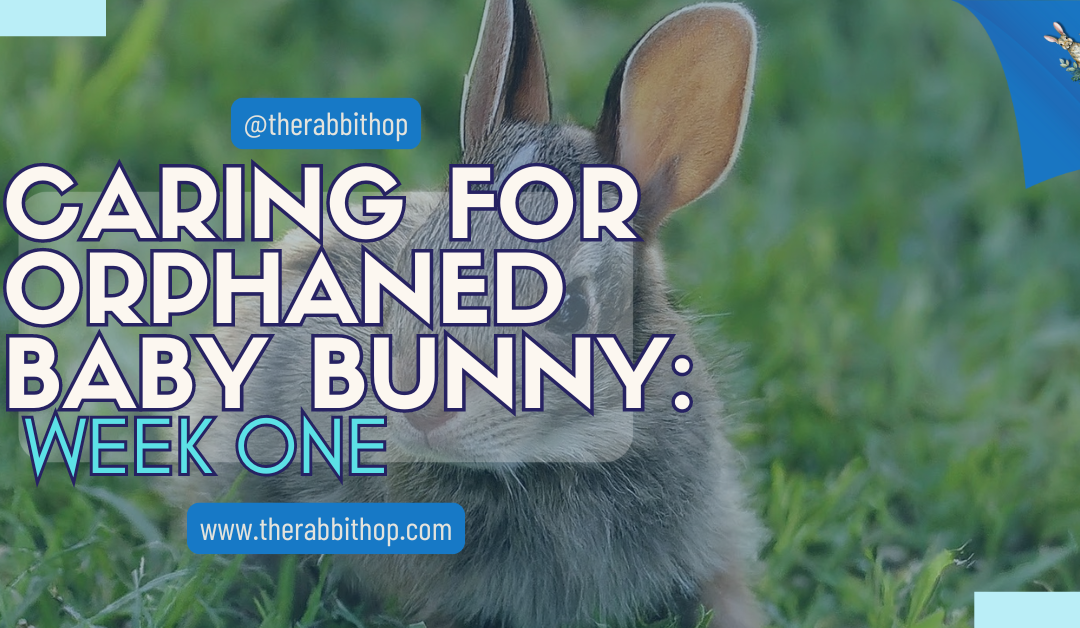Caring for orphaned baby bunny can seem daunting when you first discover a tiny, helpless bunny in your backyard. Welcome to the world of bunny parenting! The first week is a delicate and rewarding journey. This guide will walk you through the critical steps to ensure your little one gets the best possible start in life. We’ve got you covered, from feeding schedules to creating a safe, nurturing environment. Let’s dive into the essentials and set your new furry friend on the path to health and happiness!
Caring for Orphaned Baby Bunny: A Guide to Nurturing and Support
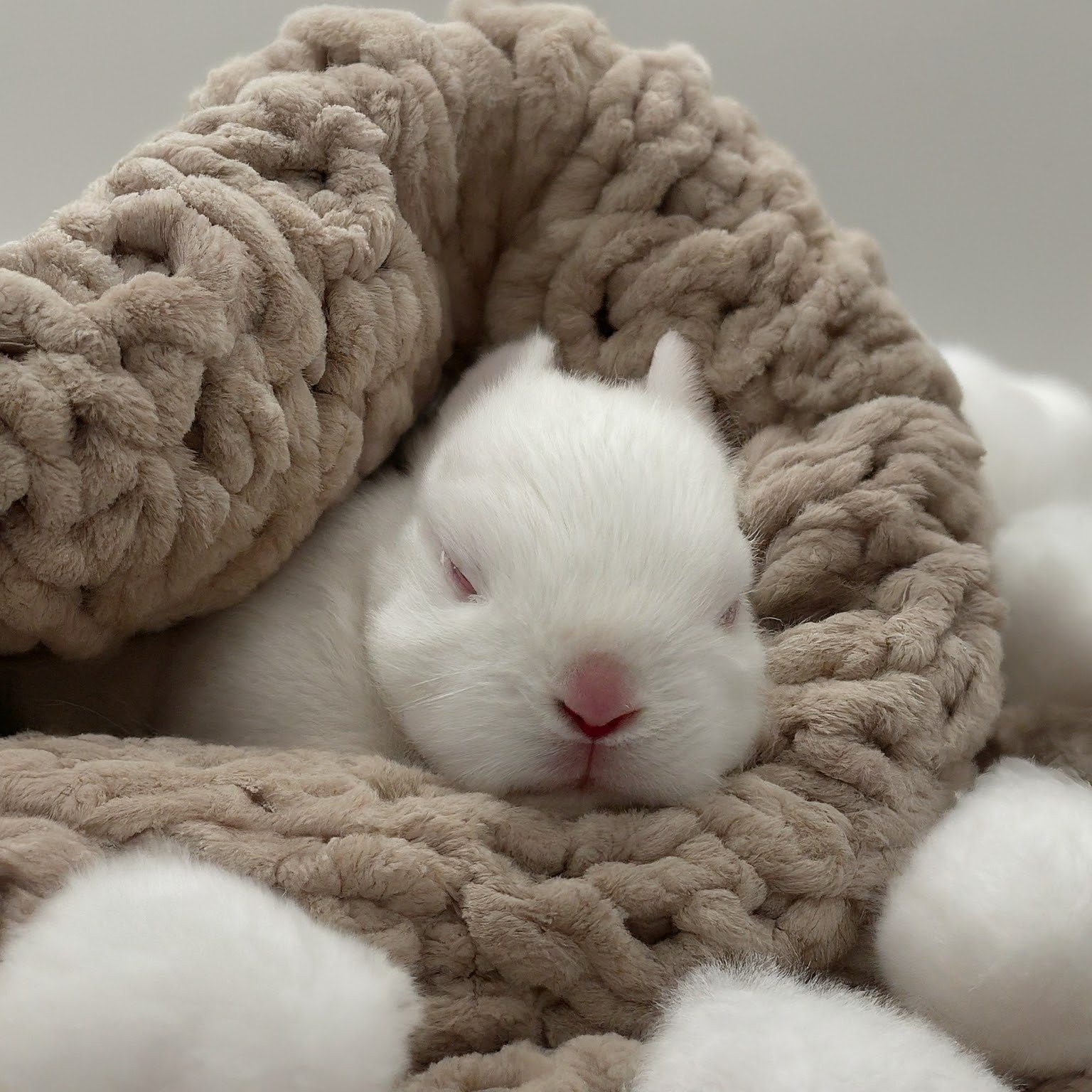
Finding an orphaned baby bunny can be heartbreaking, but it also presents an opportunity to help a vulnerable creature by caring for an orphaned baby bunny. Mother rabbits are incredibly nurturing, providing their young with warmth, nourishment, and protection.
They carefully construct nests, nurse their babies regularly, and meticulously clean their nests to maintain a healthy environment. However, human care becomes essential when a mother is absent or unable to care for her offspring.
Key Takeaways
- Baby bunnies must be kept at a consistent temperature of around 100°F during their first week. Unlike adult rabbits, newborns cannot regulate their body temperature and rely on external heat sources and a well-insulated environment to stay warm.
- Newborn bunnies require frequent feedings, typically 3 to 4 times a day. It’s crucial to use appropriate milk replacers like goat milk or KMR kitten milk replacers, as cow’s milk is unsuitable and can cause digestive problems.
- To successfully care for an orphaned bunny, replicate the care a mother rabbit would provide. This includes creating a warm and safe nesting area and feeding the bunny with rich, concentrated milk to match the nutritional needs of natural rabbit milk.
- Establish a strict daily routine, including feeding, temperature checks, and monitoring the bunny’s health. Use tools like a scale to track weight and a thermometer to ensure the environment remains within the optimal temperature range.
- Caring for an orphaned bunny requires significant time and dedication. Be prepared for some bunnies not surviving due to inherent health issues. Understanding that not all orphans will thrive can help manage expectations and ensure you provide the best possible care.
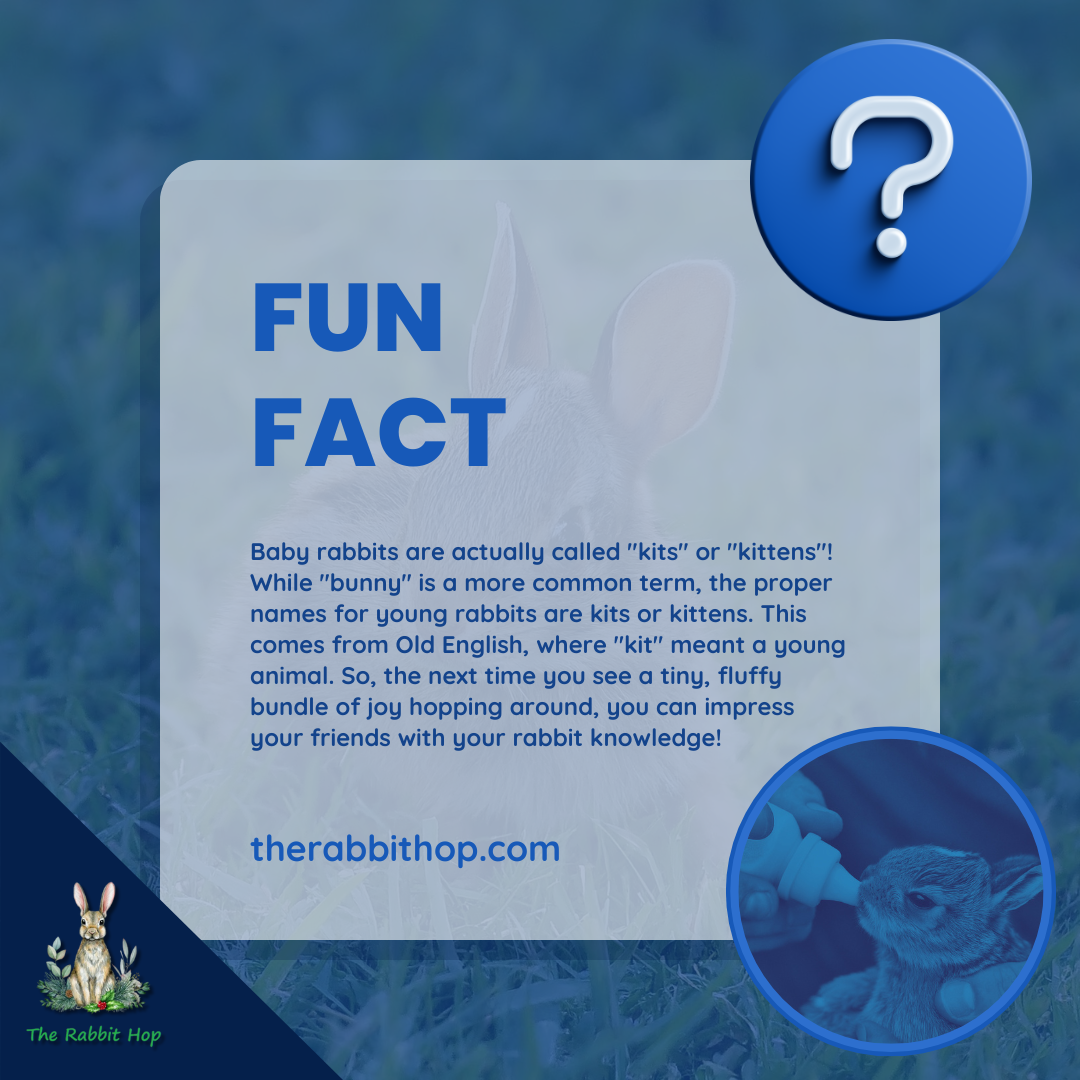
How Mother Rabbits Care for Their Baby Rabbits
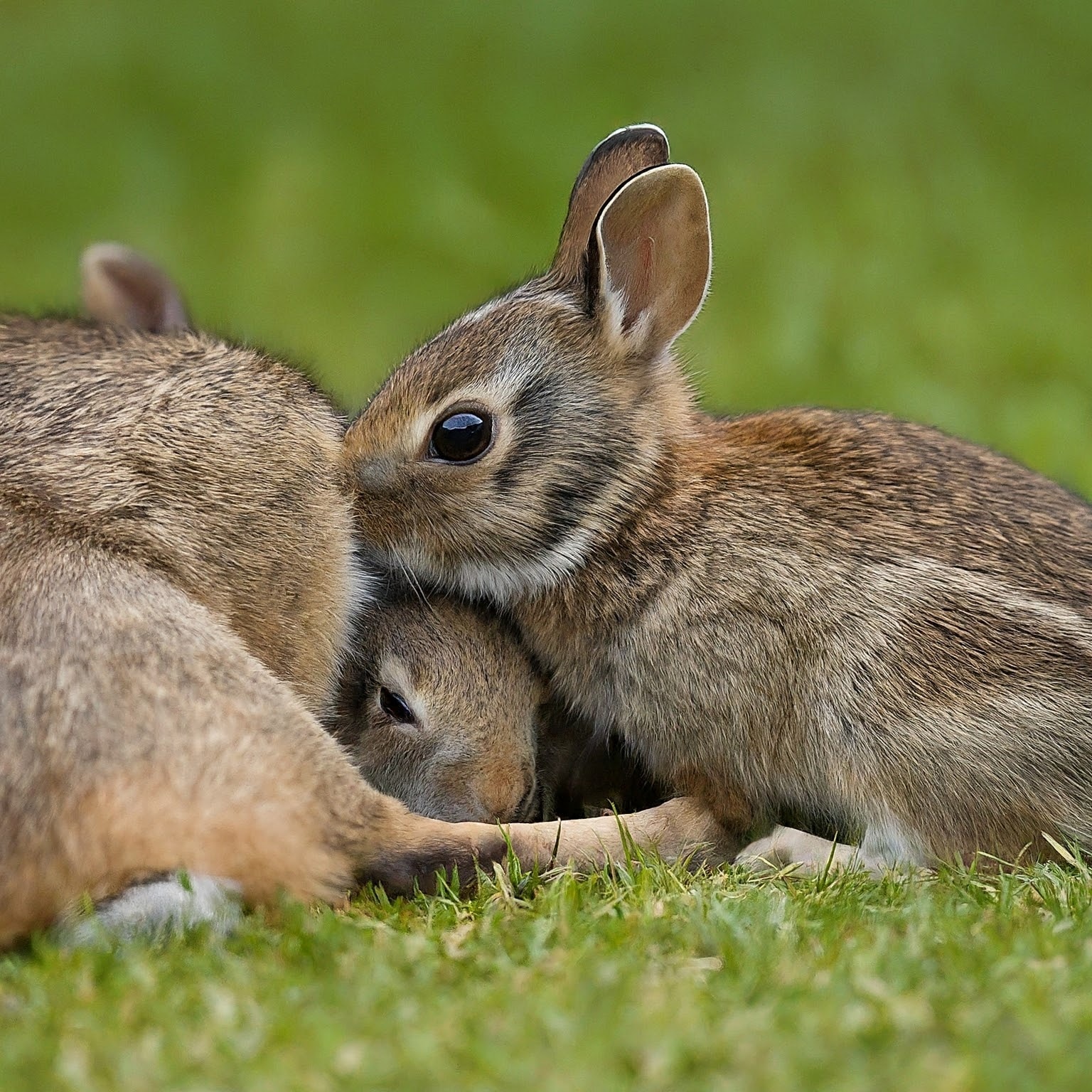
When caring for orphaned baby bunny, it’s essential to understand how mother rabbits naturally handle the job. They nurse their babies for about 5 minutes each day, typically visiting the nest early in the morning and again in the evening. The milk is wealthy, so the babies fill up quickly.
Unlike some mammals and birds that keep their young warm by sitting on them, mother rabbits rely on a carefully constructed nest made of fur and grasses to keep their babies cozy between feedings. It’s crucial not to force a mother rabbit to stay in the nest box, as she follows her routine to ensure her babies are well cared for. Here’s additional information on how mother rabbits care for their babies:
- Limited Visits: Mother rabbits visit their young only a few times daily for brief nursing sessions.
- Rich Milk: Their milk is highly concentrated, providing essential nutrients in small amounts.
- Nest Protection: Mother rabbits build nests for insulation and to shield their babies from predators.
- Minimal Scent: They limit their presence in the nest to reduce the risk of attracting predators.
- Cleanliness: Mother rabbits maintain a clean nest to prevent disease and protect their young.
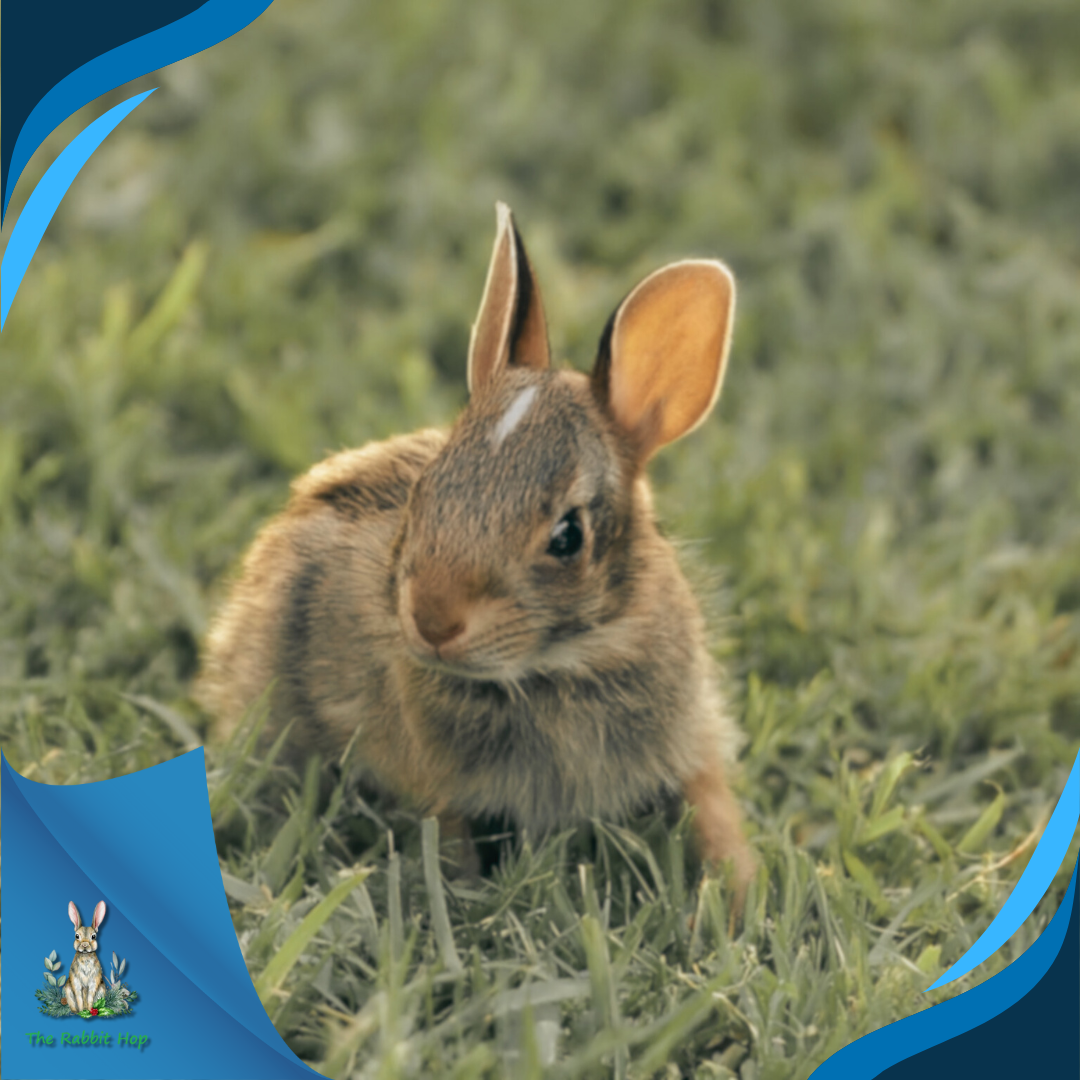
Did You Know?
Signs of dehydration in a baby bunny include lethargy, sunken eyes, and dry skin. Gently pinch the skin; if it doesn’t snap back quickly, the bunny might be dehydrated. Ensure proper feeding and consult a vet if you suspect dehydration.
Guide to Mimicking Mother Rabbit Care
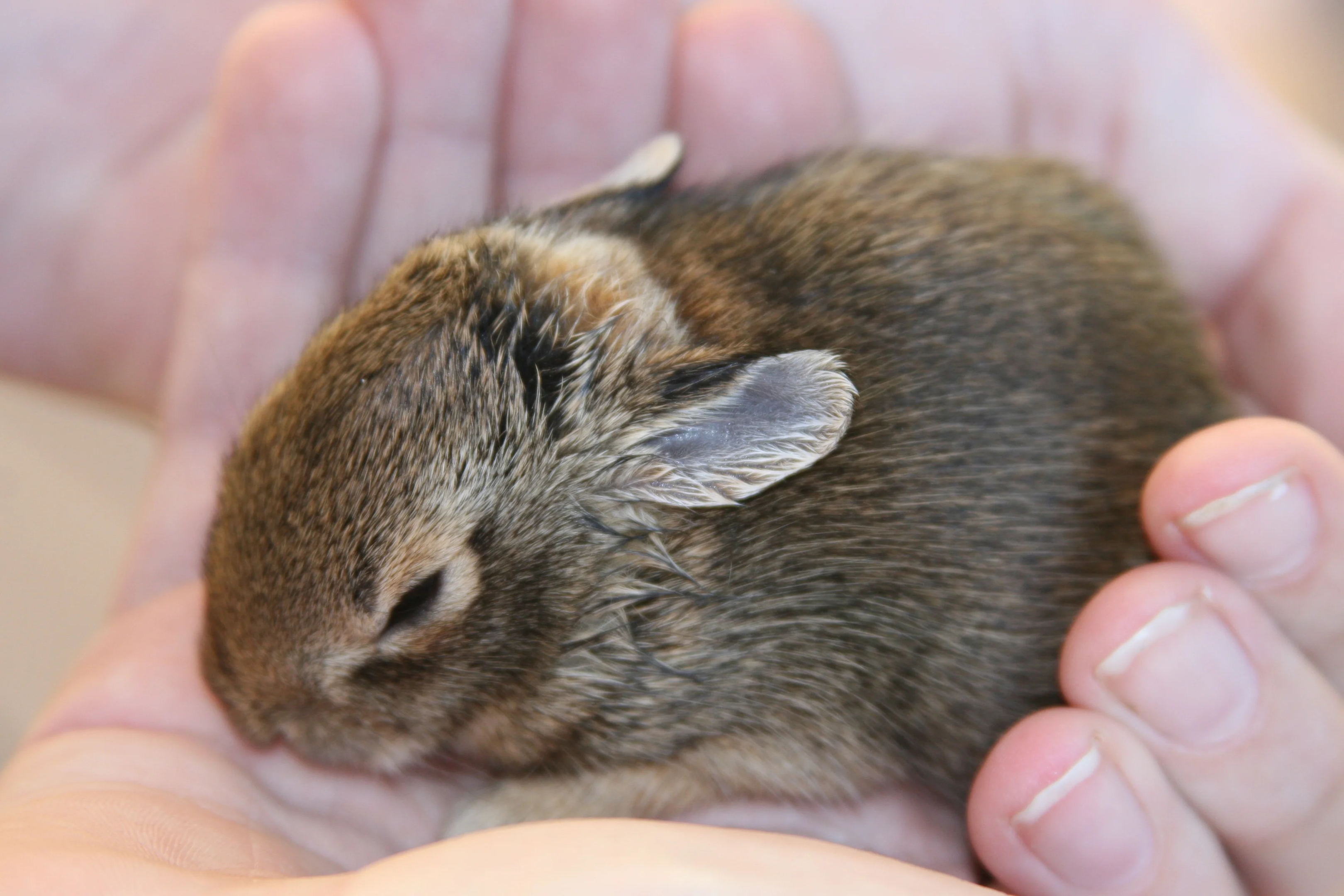
In the following sections, we will explore the delicate process of caring for orphaned baby bunny, mimicking the care a mother rabbit would provide as closely as possible.
When our friend needed someone to care for an orphaned baby bunny from her recent litter, we went to work. We’ve had experience with orphans before: rabbits, puppies, kittens, and parrots.
This was a good time to document the process for others to understand. Taking on an orphaned animal takes work. It requires time and dedication. Much like with a human baby, there is no time off. It’s continual care until the baby bunny is ready to wean.
Age When We Began
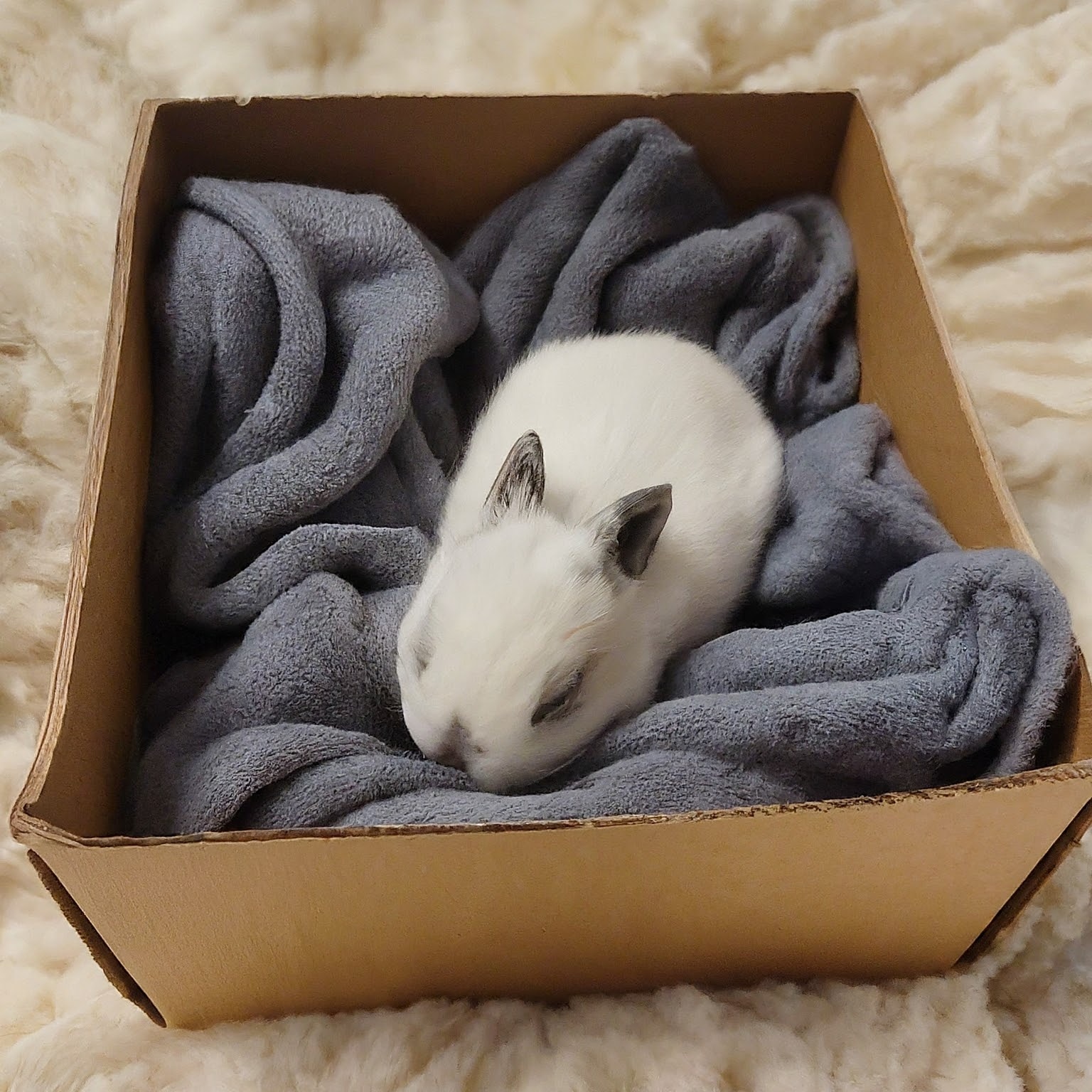
This baby was about one day old when we began caring for orphaned baby bunny. With the mom unable to care for him, he needed complete care immediately.
In this first week, our baby rabbit has no fur and looks like a skinny mouse without a long tail. The eyes are shut, as are the ears, leaving them with no sight or hearing. Instead, they rely on their senses of smell and feeling.
A healthy baby will “root” around, seeking to nurse when hungry. Our baby did this a little, but I wanted to see him more robust. He wasn’t frail, but he didn’t seem as strong as one who had nursed several times.
First Week Requirements
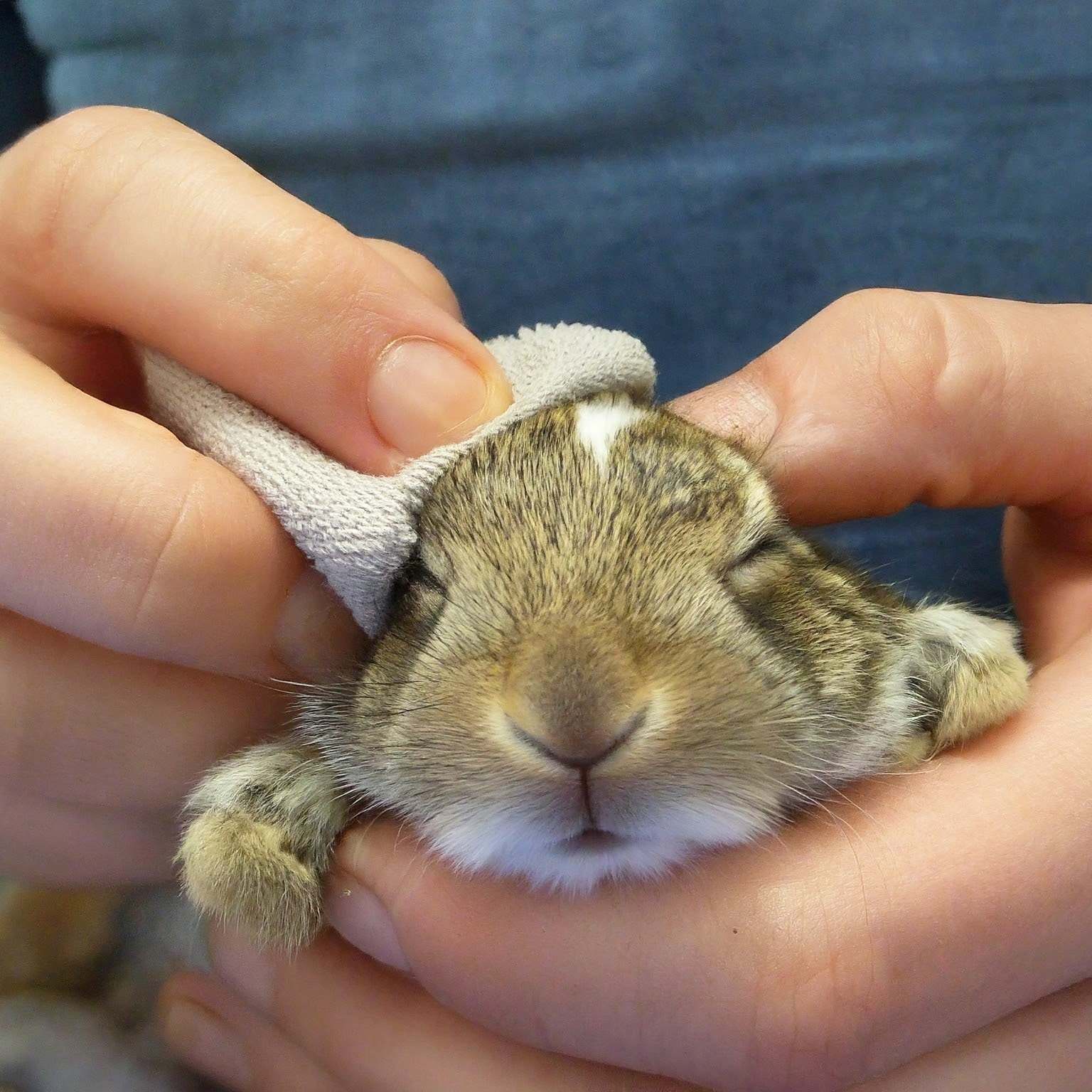
Caring for orphaned baby bunny during its first week is both a challenging and rewarding experience. This crucial period requires attentive care to ensure the baby bunny’s survival and growth. Every detail matters in these early days, from establishing a proper feeding routine to creating a warm, safe environment.
In this guide, we’ll break down the essential requirements for the first week of caring for orphaned baby bunny, providing you with the knowledge and tools needed to support your new furry friend through this delicate stage of life.
Temperature
As baby rabbits are called, newborn kits need to be kept warm (about 100°F) with good airflow. While adult rabbits maintain their ideal body temperature, as all mammals do, newborn rabbits are not able to do so.
They rely on Mom, siblings, and the warmth of the fur that Mom has pulled before giving birth. We have a warm mud room area that helps our newborn orphans when needed. Adding a heating pad can help regulate the temperature to the ideal point, about 100°F, the first week.
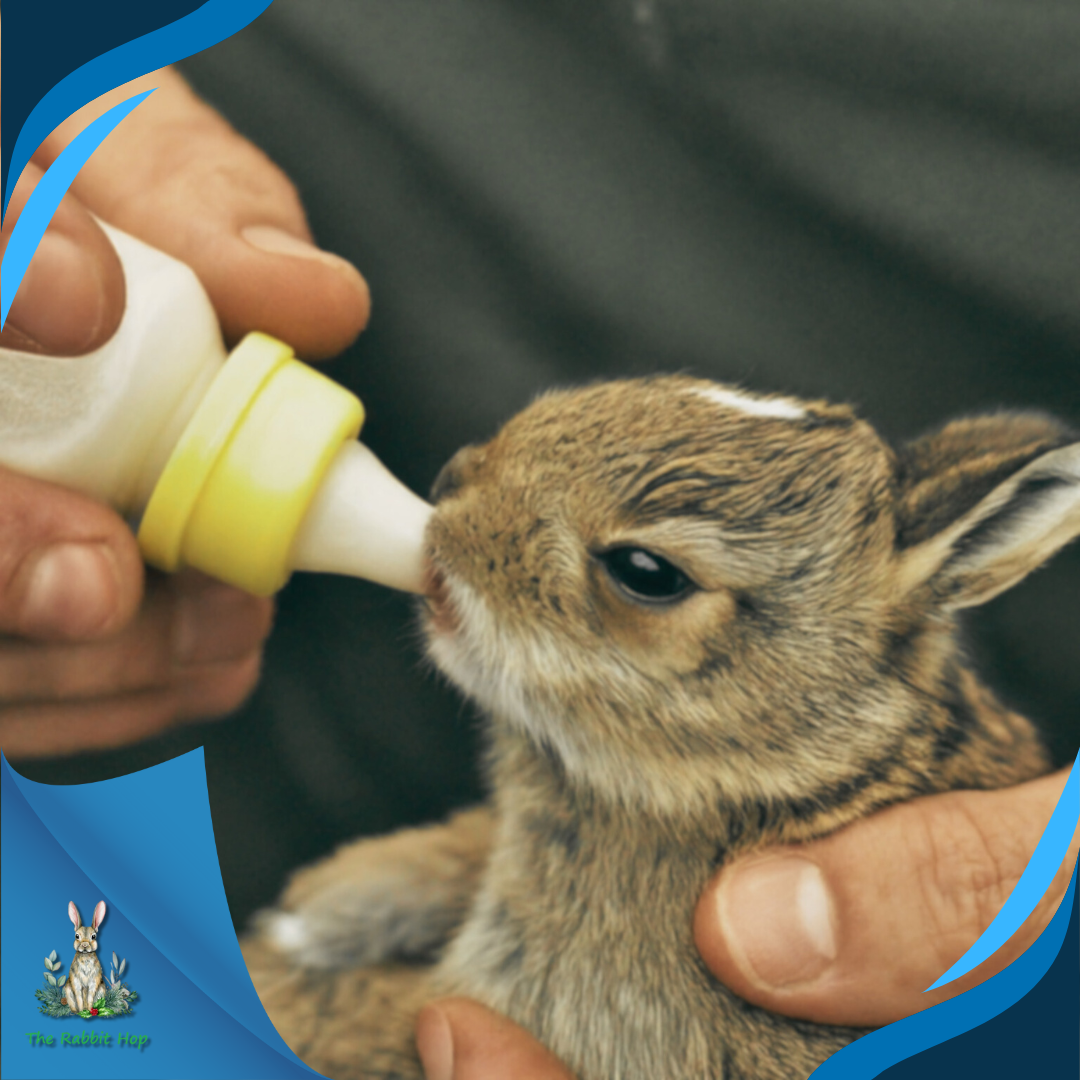
Feeding
They also need more frequent feedings. While mom bunnies feed their kits only once or twice a day, we have found better success with newborns by feeding 3 to 4 times a day to start, then edging off to 2 times.
Occasionally, more frequent feedings help to save a weaker individual. But planning at least three times a day works for most. We have a few dairy goats, so the preferred milk, goat milk, is readily available for any orphans. I’d use a KMR kitten milk replacer if that were not available.
I keep syringes on hand for orphans and for medicating any of our pets when needed. We also have tiny bottles for feeding. The PetAg Bottle comes with several nipple options, making it easy to switch as the baby grows. We keep the two-pack on hand to ensure a backup.
Other Supplies
I keep soft clothes, including my favorite Microfiber towels, on hand to clean and dry off any drips. A reliable heating pad and thermometer help to regulate the temperature. A box such as the pet habitat must keep the baby in. A ventilated lid is necessary as baby bunnies develop a love of jumping at a very young age.
Extras That Are Helpful
- Scale to weigh baby each day
- Insulated cup to heat milk bottle (never use the microwave! It can cause hot spots)
- Soft cloth for bedding (if rabbit fur is not available)
Here’s an additional video on bottle-feeding baby bunnies.
By: TeeDiddlyDee
Caring for Orphaned Baby Bunny: Daily Routine
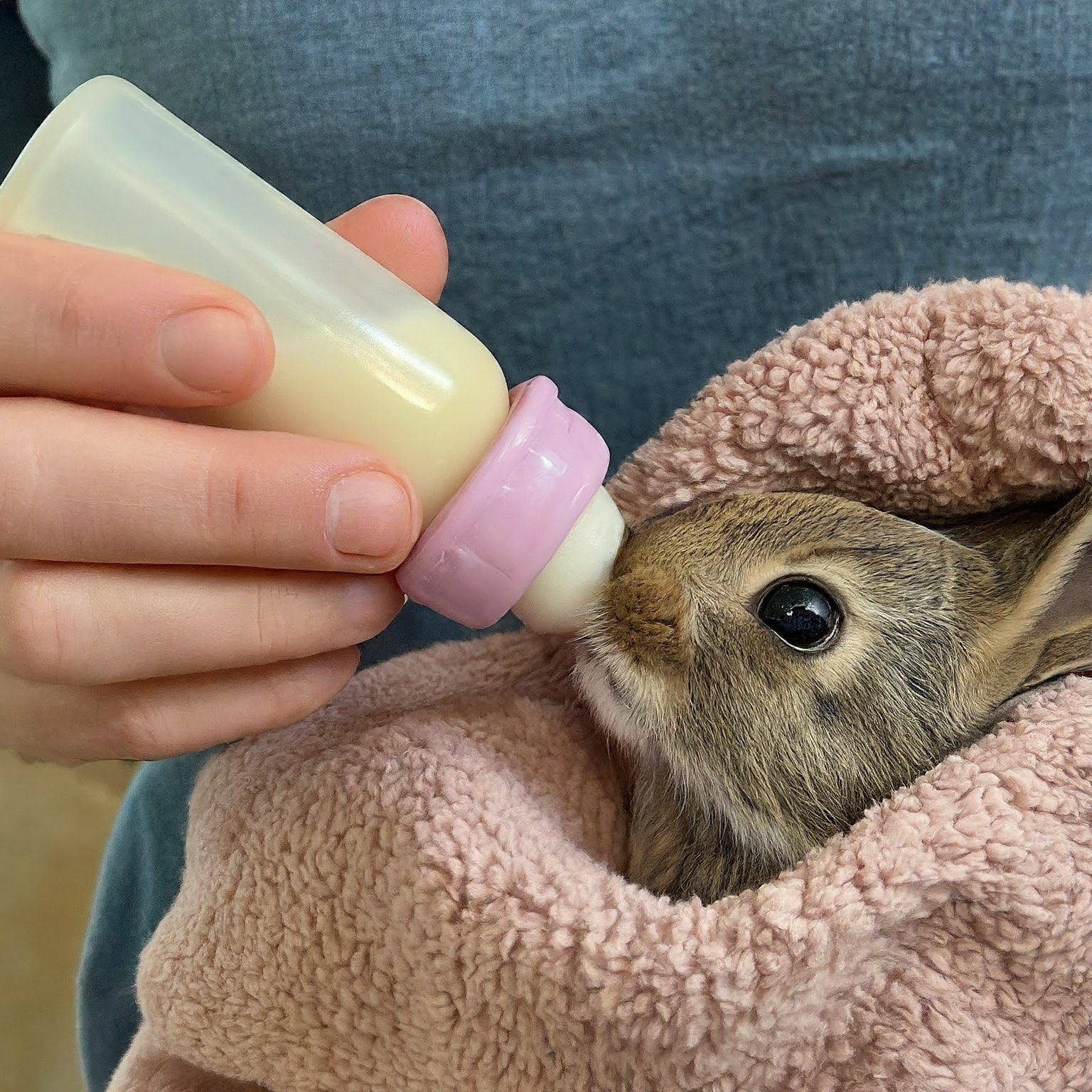
7 a.m.:
- Heat water, put it in a cup, and use it to warm the milk in the bottle. We feed milk at 102°F.
- Examine baby. Weigh and record weight. Note any possible problems.
- Feed baby. Make sure the bedding is clean and dry. Replace any as needed.
- Stimulate his elimination. Clean and dry as needed.
- Check the temperature of his container. Adjust as needed.
2 p.m.: Repeat 7 a.m. list
9 p.m.: Repeat the 7 a.m. list. Do a final night check before allowing him to rest for the night. Sometimes, I need to check again after this feeding if something does not seem quite right.
Note: We also check the temperature of his container throughout the day. Slight variations are not a problem, but catching a significant jump or drop is essential for the baby’s well-being. At this age, they cannot control their body temperature.
Simple? Not Quite
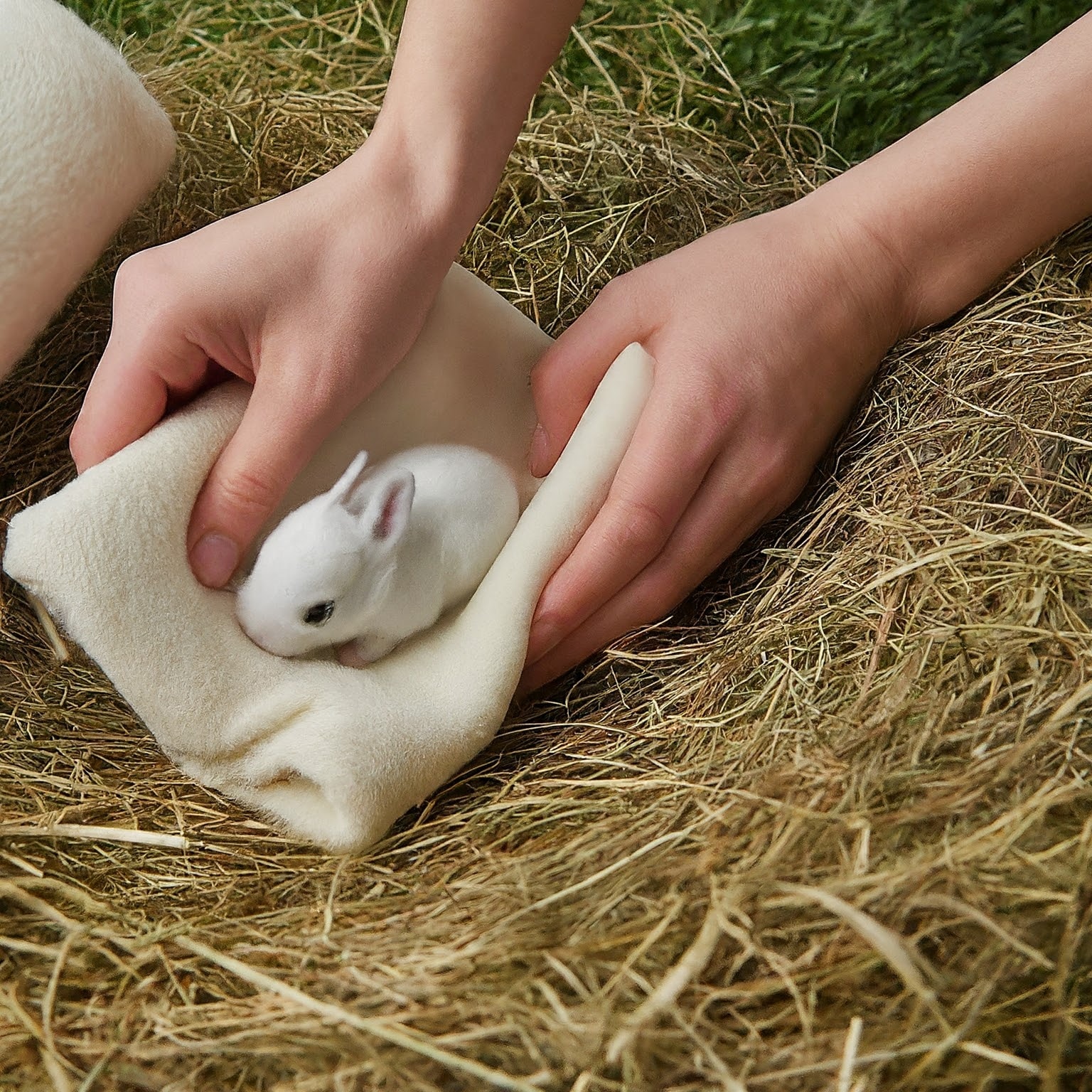
Yes, this is a simple routine. And it can be. But when it comes to caring for orphaned baby bunny, we need to be ready for a little extra work, perhaps a check and even another feeding at 3 a.m. Babies are very prone to fading, dehydration, and failing. We give them the best natural care possible.
Even so, anyone feeding orphans needs to understand that many are orphaned for a reason. If the mother rabbit pushes one kit away from the others, she often knows it has a problem. You may try to save it, of course. But often, we find these babies fade and fail to live. Like most of life, Moms usually know best.
However, if the problem is that something happened to the mom and she cannot care for her babies, as was this case, caring for an orphan kit can be done successfully. Even in these times, we know that some will fail. We try our best. It’s all we can do.
Caring for Orphaned Baby Bunny: Current Age

Our orphan kit is now six days old. So far, he is healthy, although he is slower than expected at gaining weight. I’m optimistically cautious about his future.
Here’s an additional video on how to rescue baby bunnies and keep them alive.
By: Bloom Where You’re Planted
Nurturing New Beginnings: Essential Care for Orphaned Baby Bunny’s First Week
Caring for orphaned baby bunny during its first week is a journey that demands dedication, patience, and a lot of love. This critical period sets the foundation for your bunny’s health and development, making it essential to closely follow guidelines for feeding, temperature regulation, and overall care. By replicating the warmth, nourishment, and protection that a mother rabbit would provide, you’ll help your little one thrive despite the absence of its natural mother.
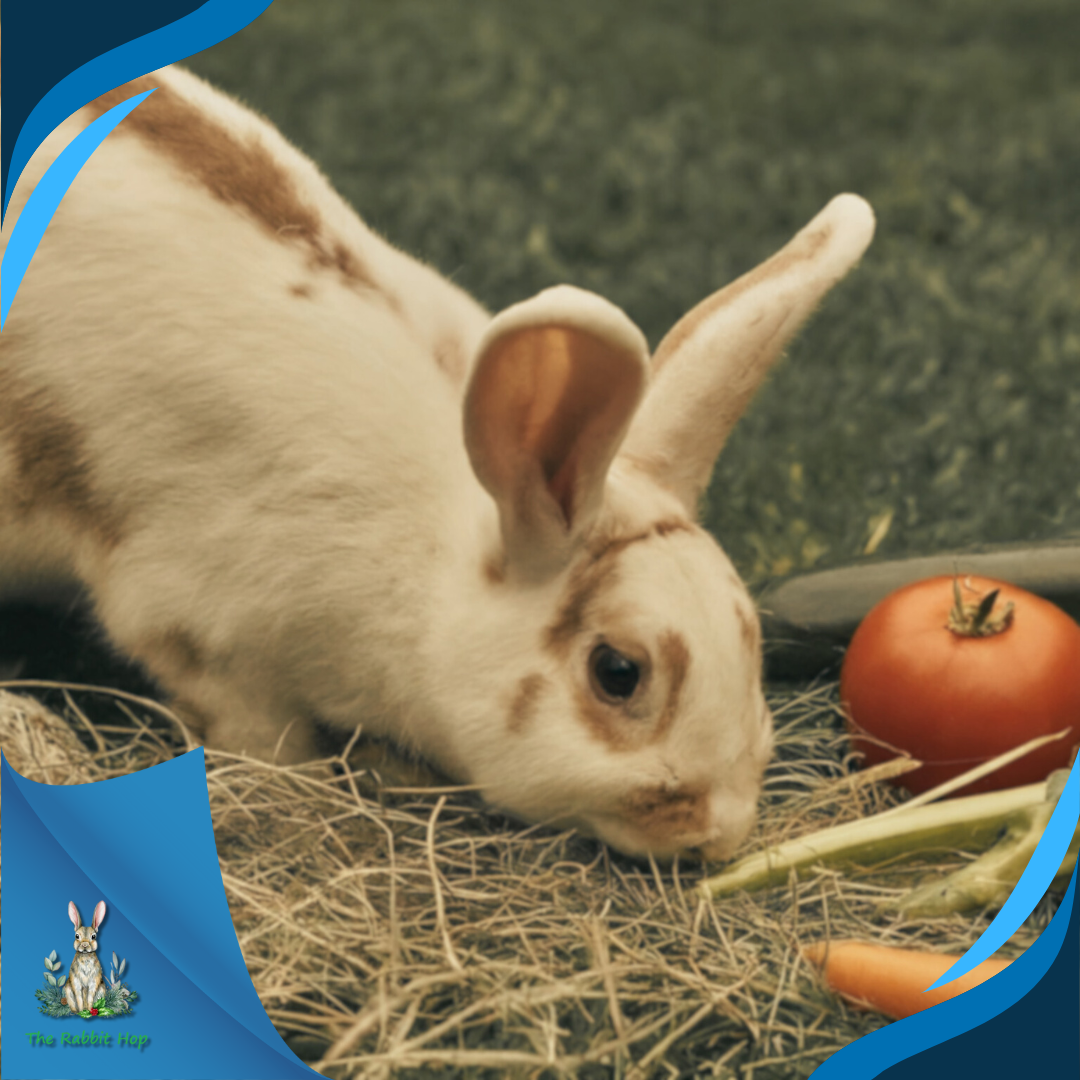
While the process can be challenging and requires constant vigilance, the rewards of seeing your baby bunny grow stronger each day are truly worth it. Embracing this responsibility with care and preparation ensures your orphaned bunny receives the best possible start in life. Remember, your commitment and attentive care are crucial in overcoming challenges and ensuring your new furry friend’s healthy, happy future.
Frequently Asked Questions
What Should I Do if the Baby Bunny Isn't Drinking Enough Milk?
If the baby bunny isn’t drinking enough milk, ensure the milk is at the right temperature (around 102°F). Gently stimulate the bunny’s mouth with the bottle or syringe and try feeding more frequently. If the problem persists, consult a vet for advice.
How Often Should I Check the Temperature of a Baby Bunny?
It’s essential to check the temperature of the baby bunny’s environment regularly, ideally every few hours, to ensure it stays around 100°F. Adjust the heating pad or other heat sources as needed to maintain a consistent, warm environment.
Can I Use Regular Cow's Milk for Feeding the Baby Bunny?
Cow milk is unsuitable for baby bunnies as it lacks the necessary nutrients and can cause digestive issues. Use goat milk or a specialized milk replacer designed for kittens, such as KMR, which provides the appropriate nutrients.
What Are the Best Materials for Creating a Nest for the Baby Bunny?
Create a nest using soft materials like clean rabbit fur or soft cloths. Avoid using materials that could be harmful if ingested. The nest should be warm, dry, and well-ventilated to keep the bunny comfortable and safe.
When Should I Start Introducing Solid Food to the Baby Bunny?
Introduce solid food gradually around 3 to 4 weeks of age. Start with soft, easily digestible options like fresh hay and finely chopped vegetables. Consult a vet for specific recommendations based on the bunny’s growth and development.
Connect with Us and Hop Along on Social Media!
Do you have a soft spot for your bunny? So do we at The Rabbit Hop!
Visit us online for:
- Bunny Fun: Enjoy cute videos, discover interesting facts, and get tips for keeping your bunny happy!
- Top Product Reviews: Discover the best products for your fluffy friend.
- Bunny Community: Connect and engage with other bunny enthusiasts just like you.
Follow us on:
Let’s help your bunny be the happiest one in the neighborhood!

